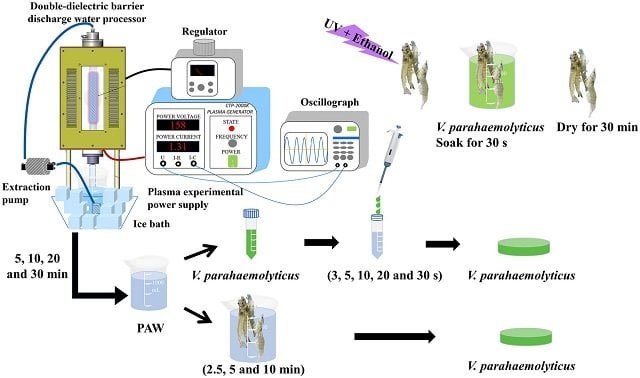
Fresh seafood is a delicious and nutritious part of our diet, but it can also harbor harmful bacteria. Vibrio parahaemolyticus, a common culprit, lurks in marine and freshwater environments, contaminating shrimp, crabs, oysters, and other delights. This unpleasant bacterium not only causes economic losses in the aquaculture industry but also poses a serious threat to human health, leading to foodborne illnesses.
Traditionally, food processors have relied on methods such as ultraviolet light or high pressure to eliminate pathogens. However, these techniques have limitations. They may not reach all corners of the food, leaving bacteria behind.
A team of scientists from Guangdong Ocean University, the Key Laboratory of Advanced Processing of Aquatic Product of Guangdong Higher Education Institution, The University of Haripur, Wuhan Institute of Technology, and Dalian Polytechnic University investigated the antimicrobial mechanism of plasma-activated water (PAW) against Vibrio parahaemolyticus and the efficacy of PAW on artificially contaminated Litopenaeus vannamei shrimp.
The War Against Vibrio parahaemolyticus
This study explores a novel approach using plasma-activated water (PAW) to combat Vibrio parahaemolyticus, a bacterium responsible for foodborne illnesses and spoilage.
Vibrio parahaemolyticus is an unpleasant bacterium that lurks in our oceans and causes foodborne illnesses through contaminated seafood.
Plasma-Activated Water (PAW)
Plasma-activated water (PAW) is an emerging method in the fight against foodborne illnesses. PAW is a safe and effective disinfectant created by treating water with special equipment. This innovative technology offers several advantages:
- Powerful disinfection: PAW uses a double strike against bacteria. It creates oxidative stress within the bacterial cell, disrupting its vital functions, while also impacting the cell membrane, causing leaks and ultimately cell death.
- Superior penetration: Unlike other methods, PAW has excellent permeability. It can infiltrate small cracks within foods, ensuring a more thorough disinfection process.
- Environmentally friendly: PAW avoids harsh chemicals, making it a safer option for both consumers and the environment.
- Cost-effective and versatile: PAW is easy to produce and can be used in batch processes, making it a practical solution for commercial food processing.
Impact of PAW Against V. parahaemolyticus
Researchers studied how PAW affects V. parahaemolyticus and its efficacy in decontaminating artificially contaminated shrimp (Litopenaeus vannamei) with the bacteria. The results are promising!
Significant reduction in bacterial count: Exposure of bacteria to PAW for longer periods (both in terms of plasma discharge time and immersion time) led to a significant decrease in viable V. parahaemolyticus cells. In some cases, bacterial counts were reduced by more than 4 logs (a 99.99% reduction)!
Stay Always Informed
Join our communities to instantly receive the most important news, reports, and analysis from the aquaculture industry.
How Does PAW Work?
The study suggests that PAW disarms V. parahaemolyticus in several ways:
- Membrane damage: PAW appears to damage bacterial cell membranes, causing wrinkles and leaks of essential cellular components such as nucleic acids and proteins.
- Increased permeability: This damage significantly increases the permeability of both internal and external bacterial cell membranes, essentially making the bacteria more vulnerable.
- ROS increase: PAW treatment also leads to an increase in reactive oxygen species (ROS) within the bacteria. These ROS molecules are highly reactive and can damage vital cellular components.
- Weakening of defense system: The study also observed a decrease in the activity of superoxide dismutase (SOD), an enzyme that helps bacteria combat ROS. Additionally, crucial genes for survival and bacterial communication were downregulated.
Shrimp Saved from Spoilage
The good news extends beyond laboratory experiments. Exposure of artificially contaminated shrimp to PAW for just 5 minutes significantly reduced levels of V. parahaemolyticus.
The study highlights the potential of PAW as a safe and effective method for controlling Vibrio parahaemolyticus in shrimp aquaculture. PAW offers a non-chemical alternative to traditional disinfectants, potentially minimizing environmental impact and ensuring safer seafood products for consumers.
Conclusion
“The study clarified that PAW could destroy cell membranes and cause cell death. The findings would strengthen strategies for V. parahaemolyticus control and provide a potential application of PAW for preserving aquatic products,” concluded the researchers.
However, researchers recommend further investigation to optimize PAW application methods in large-scale aquaculture environments.
This study highlights the potential of PAW as a safe and effective method for controlling V. parahaemolyticus in seafood products. PAW offers several advantages:
- Ecological: Unlike traditional disinfectants, PAW leaves no harmful residues.
- Targeted: PAW appears to target bacteria, leaving beneficial shrimp elements untouched specifically.
- Versatile: The study suggests that PAW could be applied throughout the seafood processing chain, from aquaculture to post-harvest preservation.
The study was funded by the National Key R&D Program of China, Key Project of the Department of Education of Guangdong Province, China Agriculture Research System, and the Innovation Team Program of Guangdong Ocean University.
Reference (open access)
Zhang, H., Wei, J., Xv, H., Khan, I., Sun, Q., Zhao, X., Gao, J., Liu, S., & Wei, S. (2024). Bactericidal efficacy of plasma-activated water against Vibrio parahaemolyticus on Litopenaeus vannamei. Frontiers in Nutrition, 11, 1365282. https://doi.org/10.3389/fnut.2024.1365282
Editor at the digital magazine AquaHoy. He holds a degree in Aquaculture Biology from the National University of Santa (UNS) and a Master’s degree in Science and Innovation Management from the Polytechnic University of Valencia, with postgraduate diplomas in Business Innovation and Innovation Management. He possesses extensive experience in the aquaculture and fisheries sector, having led the Fisheries Innovation Unit of the National Program for Innovation in Fisheries and Aquaculture (PNIPA). He has served as a senior consultant in technology watch, an innovation project formulator and advisor, and a lecturer at UNS. He is a member of the Peruvian College of Biologists and was recognized by the World Aquaculture Society (WAS) in 2016 for his contribution to aquaculture.




